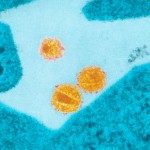Lien vers Pubmed [PMID] – 11356952
J. Virol. 2001 Jun;75(12):5457-64
Human immunodeficiency virus type 1 (HIV-1) entry is triggered by the interaction of the gp120 envelope glycoprotein with a cellular chemokine receptor, either CCR5 or CXCR4. We have identified different mutations in human CXCR4 that prevent efficient infection by one HIV-1 strain (NDK) but not another (LAI) and sought to define these strain-dependent effects at the gp120 level. The lack of activity toward the NDK strain of the HHRH chimeric CXCR4 in which the second extracellular loop (ECL2) derived from the rat CXCR4 and of CXCR4 with mutations at an aspartic acid in ECL2 (D193A and D193R) was apparently due to the sequence of the third variable loop (V3) of gp120, more precisely, to its C-terminal part. Indeed, substitution of the LAI V3 loop or only its C-terminal part in the NDK gp 120 context was sufficient to restore usage of the HHRH, D193A, and D193R receptors. The same result was achieved upon mutation of a single lysine residue of the NDK V3 loop to alanine (K319A) but not to arginine (K319R). These results provide a strong case for a direct interaction between the gp120 V3 loop and the ECL2 domain of CXCR4. By contrast, V3 substitutions had no effect on the inability of NDK to infect cells via a mutant CXCR4 in which the amino-terminal extracellular domain (NT) is deleted. In experiments with a set of chimeric NDK-LAI gp120s, the V1/V2 region from LAI gp120 was both necessary and sufficient for usage of the NT-deleted CXCR4. Different variable domains of gp120 can therefore cooperate for a functional interaction with CXCR4.

